Communication Strategies Report: Workplace Scenarios and Analysis
VerifiedAdded on 2020/02/18
|13
|2118
|41
Report
AI Summary
This report examines two workplace communication scenarios, providing detailed analyses and strategic approaches. The first scenario focuses on utilizing non-verbal communication during a job interview to assess the interviewer, covering audience analysis, communication goals, process, and timing. The second scenario addresses intercultural communication challenges with a manager from another country, analyzing the situation through the lens of intercultural communication models. The report provides a breakdown of audience analysis, communication goals, the communication process, and timing considerations. It emphasizes the importance of adapting communication styles to different contexts, including the significance of non-verbal cues and the application of intercultural communication models for effective management. The report provides a comprehensive framework for improving professional communication skills in diverse workplace settings.
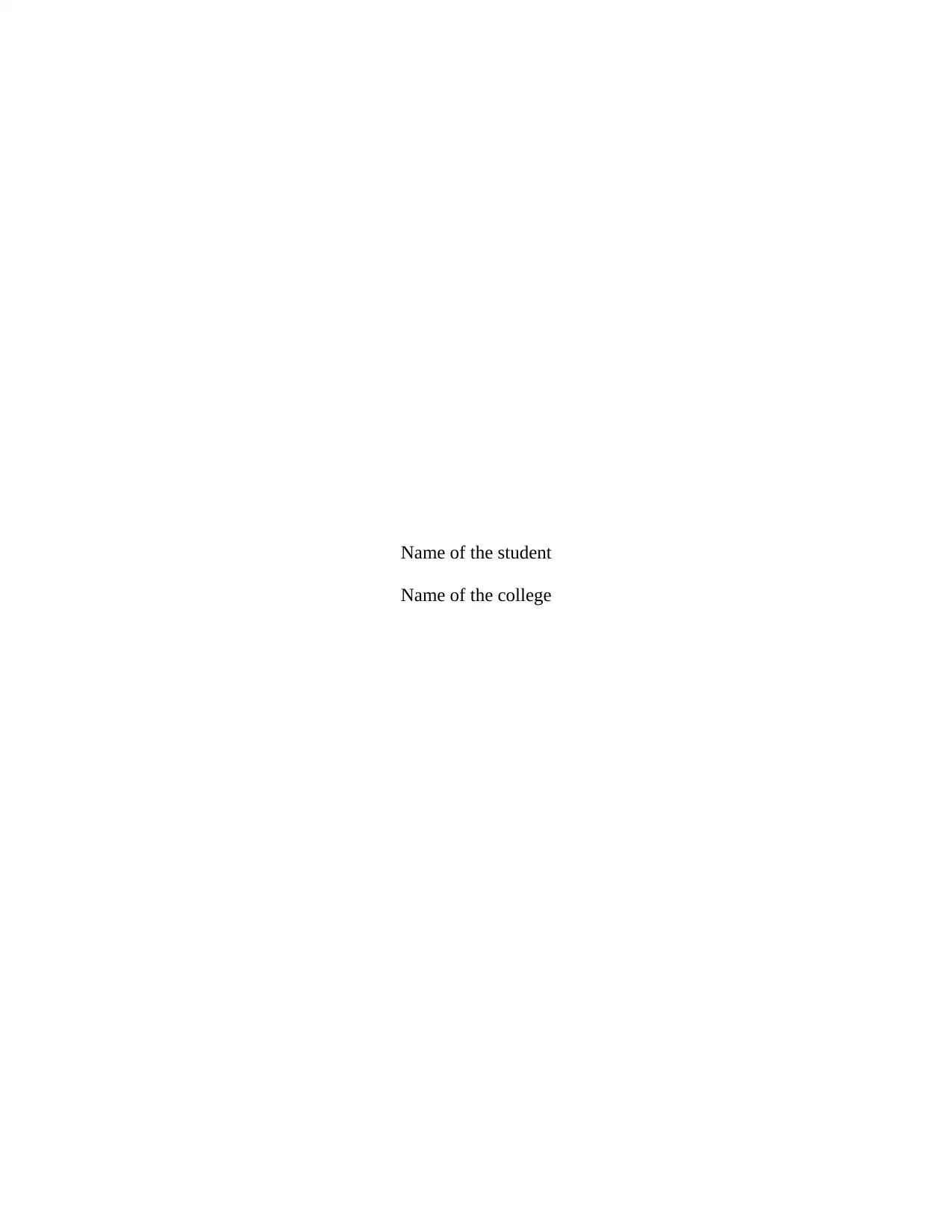
Name of the student
Name of the college
Name of the college
Paraphrase This Document
Need a fresh take? Get an instant paraphrase of this document with our AI Paraphraser

Abstract
In the following paper, we would be talking about our communication approach for given two
scenarios and we would be dividing our answer in to several parts which includes audience
analysis, communication goals, communication process and timing. We have been given 4
scenarios and the two scenarios we chose are of a setting where we are supposed to do a non-
verbal interview with the interviewer and the other case is of intercultural communications skills
where the other manager is from another country.
In the following paper, we would be talking about our communication approach for given two
scenarios and we would be dividing our answer in to several parts which includes audience
analysis, communication goals, communication process and timing. We have been given 4
scenarios and the two scenarios we chose are of a setting where we are supposed to do a non-
verbal interview with the interviewer and the other case is of intercultural communications skills
where the other manager is from another country.
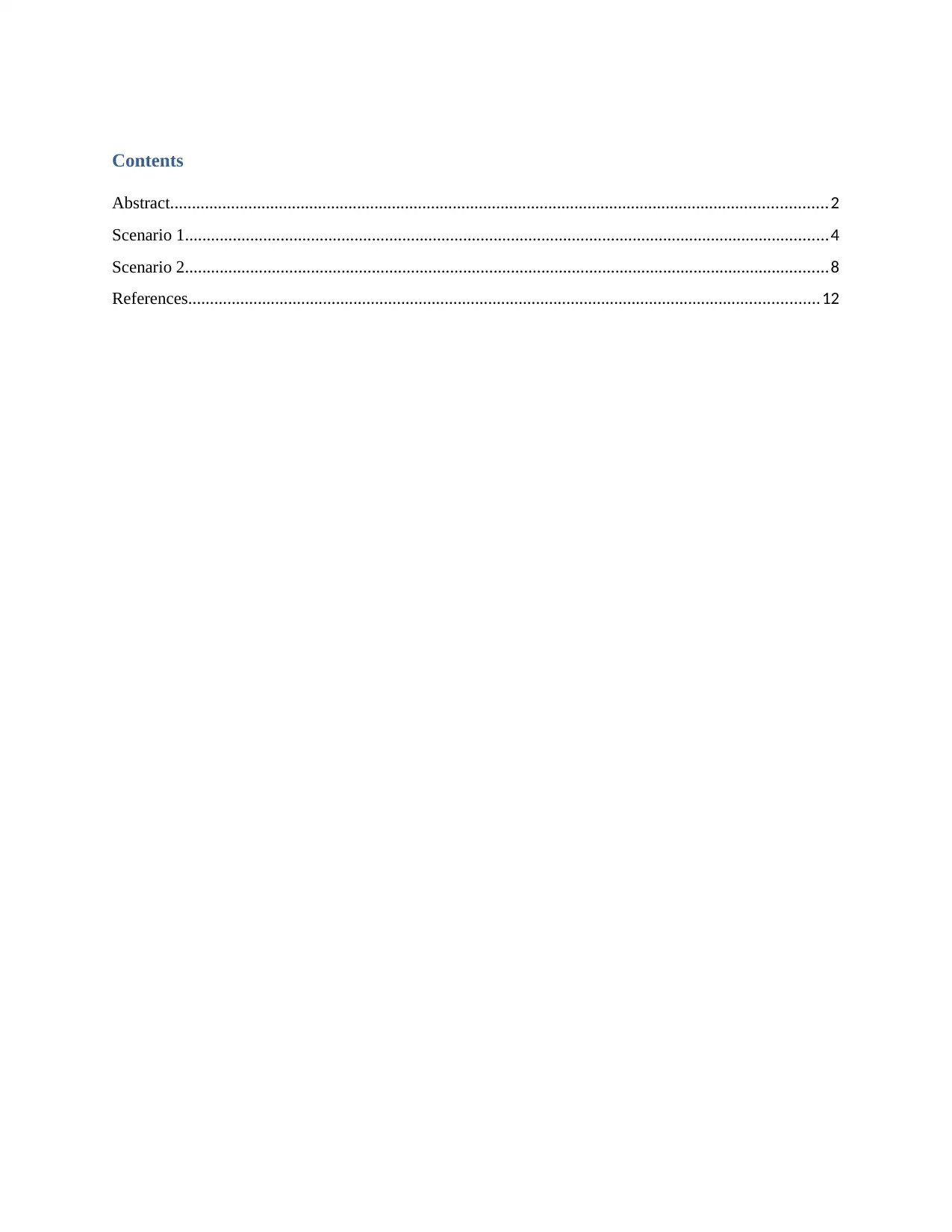
Contents
Abstract.......................................................................................................................................................2
Scenario 1....................................................................................................................................................4
Scenario 2....................................................................................................................................................8
References.................................................................................................................................................12
Abstract.......................................................................................................................................................2
Scenario 1....................................................................................................................................................4
Scenario 2....................................................................................................................................................8
References.................................................................................................................................................12
⊘ This is a preview!⊘
Do you want full access?
Subscribe today to unlock all pages.

Trusted by 1+ million students worldwide

Scenario 1
How would we use a non-verbal communication in a job interview to “interview” an
interviewer? What all different methods of non- verbal communication would be used by
us in order to extract maximum information about the job and present ourselves as
successful candidate for the company?
In this setting, we cannot afford to lose the interest of our audience and their interest in us is of
utmost importance. The conversation has to be professional and subtle as we might not be getting
nay second chance. So we are required to be peculiar as well as selective about our response and
questions.
At times, many people feel that after giving good answers in an interview they are sure of
clearing interviews but in reality more than the question, it is the other elements which hold
important position in your selection or rejection. This includes our body language and what is
known as paralanguage- these are the elements of our speech other than the words including the
speed of our speaking, in notations, sighs and pauses along with facial expressions (Doyle,
2016).
How would we use a non-verbal communication in a job interview to “interview” an
interviewer? What all different methods of non- verbal communication would be used by
us in order to extract maximum information about the job and present ourselves as
successful candidate for the company?
In this setting, we cannot afford to lose the interest of our audience and their interest in us is of
utmost importance. The conversation has to be professional and subtle as we might not be getting
nay second chance. So we are required to be peculiar as well as selective about our response and
questions.
At times, many people feel that after giving good answers in an interview they are sure of
clearing interviews but in reality more than the question, it is the other elements which hold
important position in your selection or rejection. This includes our body language and what is
known as paralanguage- these are the elements of our speech other than the words including the
speed of our speaking, in notations, sighs and pauses along with facial expressions (Doyle,
2016).
Paraphrase This Document
Need a fresh take? Get an instant paraphrase of this document with our AI Paraphraser
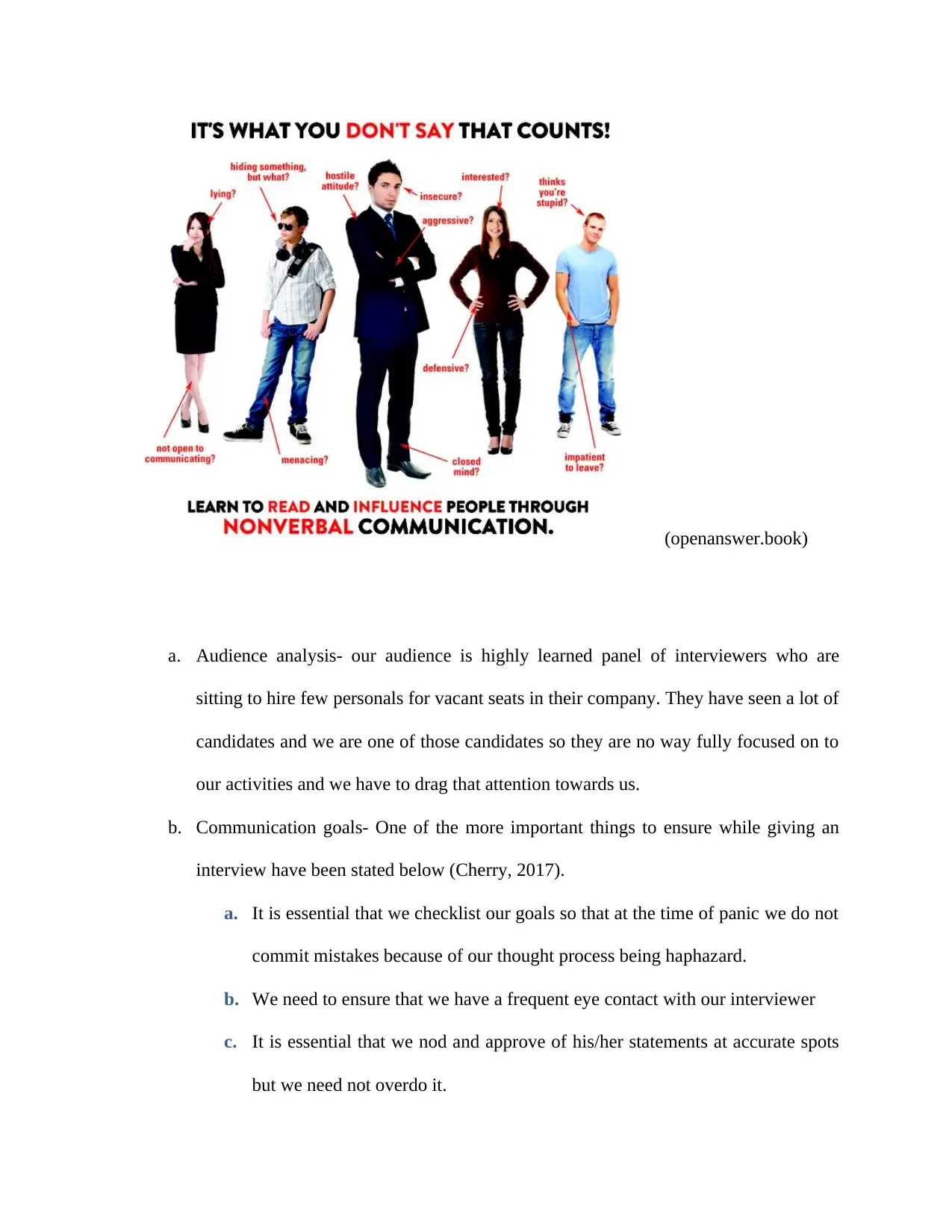
(openanswer.book)
a. Audience analysis- our audience is highly learned panel of interviewers who are
sitting to hire few personals for vacant seats in their company. They have seen a lot of
candidates and we are one of those candidates so they are no way fully focused on to
our activities and we have to drag that attention towards us.
b. Communication goals- One of the more important things to ensure while giving an
interview have been stated below (Cherry, 2017).
a. It is essential that we checklist our goals so that at the time of panic we do not
commit mistakes because of our thought process being haphazard.
b. We need to ensure that we have a frequent eye contact with our interviewer
c. It is essential that we nod and approve of his/her statements at accurate spots
but we need not overdo it.
a. Audience analysis- our audience is highly learned panel of interviewers who are
sitting to hire few personals for vacant seats in their company. They have seen a lot of
candidates and we are one of those candidates so they are no way fully focused on to
our activities and we have to drag that attention towards us.
b. Communication goals- One of the more important things to ensure while giving an
interview have been stated below (Cherry, 2017).
a. It is essential that we checklist our goals so that at the time of panic we do not
commit mistakes because of our thought process being haphazard.
b. We need to ensure that we have a frequent eye contact with our interviewer
c. It is essential that we nod and approve of his/her statements at accurate spots
but we need not overdo it.

d. We need to ensure both long term and short term goals for entire span of
interview and ensure that we have an even tone throughout and not loud at
times and quiet at other times.
e. We should not have a laid back posture and slouch otherwise it will give a
relaxed and casual impression about us.
f. The other important thing we need to ensure throughout the interview is that
we do not interrupt the interviewer and stay calm and if we feel we would
forget something then we should make notes and have a control over our
hands and not let them fly everywhere when we are making some point.
g. At the end of the interview we should ensure that we again give a firm
handshake to all the interviewers and smile at them mildly as to give them a
look of confidence.
(pjcostan.wordpress)
interview and ensure that we have an even tone throughout and not loud at
times and quiet at other times.
e. We should not have a laid back posture and slouch otherwise it will give a
relaxed and casual impression about us.
f. The other important thing we need to ensure throughout the interview is that
we do not interrupt the interviewer and stay calm and if we feel we would
forget something then we should make notes and have a control over our
hands and not let them fly everywhere when we are making some point.
g. At the end of the interview we should ensure that we again give a firm
handshake to all the interviewers and smile at them mildly as to give them a
look of confidence.
(pjcostan.wordpress)
⊘ This is a preview!⊘
Do you want full access?
Subscribe today to unlock all pages.

Trusted by 1+ million students worldwide
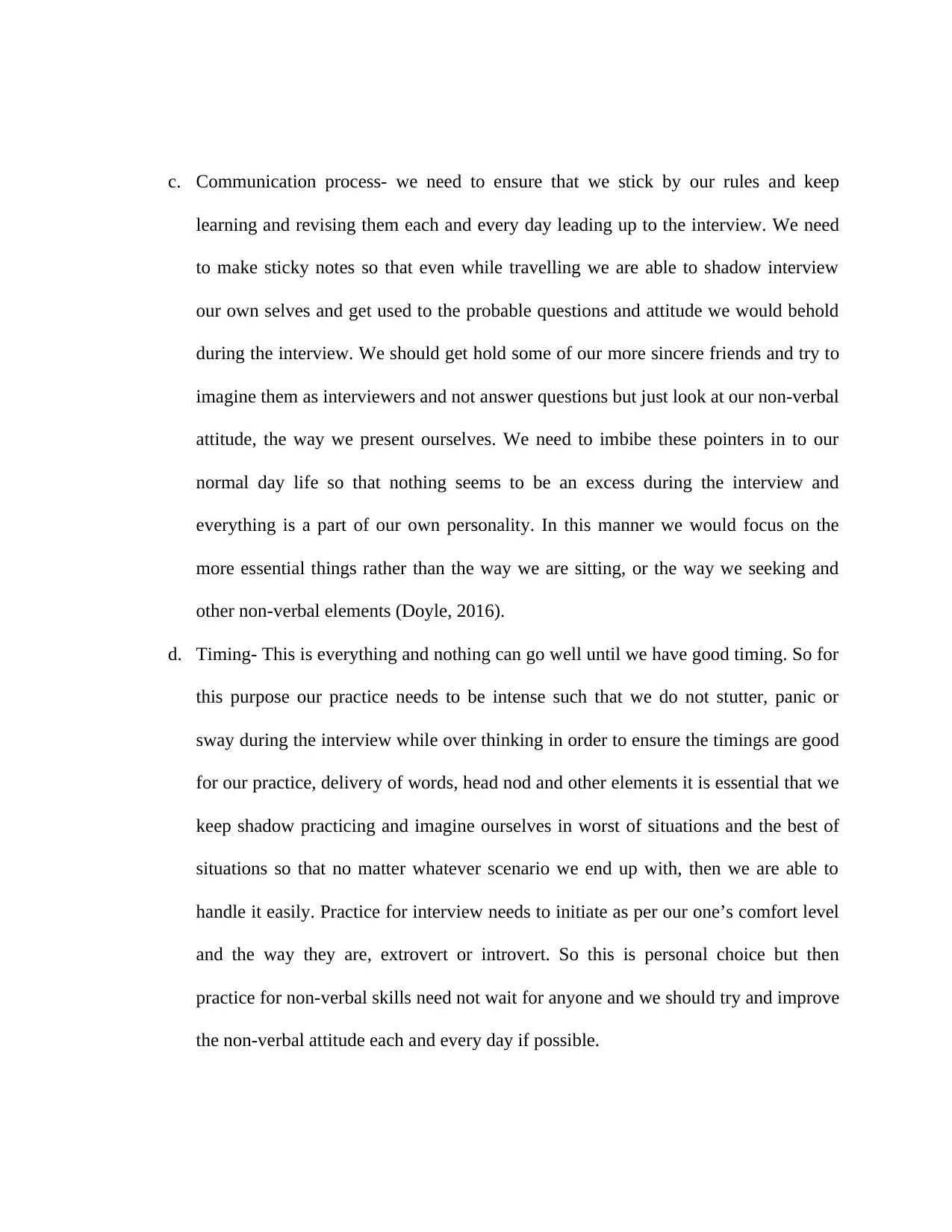
c. Communication process- we need to ensure that we stick by our rules and keep
learning and revising them each and every day leading up to the interview. We need
to make sticky notes so that even while travelling we are able to shadow interview
our own selves and get used to the probable questions and attitude we would behold
during the interview. We should get hold some of our more sincere friends and try to
imagine them as interviewers and not answer questions but just look at our non-verbal
attitude, the way we present ourselves. We need to imbibe these pointers in to our
normal day life so that nothing seems to be an excess during the interview and
everything is a part of our own personality. In this manner we would focus on the
more essential things rather than the way we are sitting, or the way we seeking and
other non-verbal elements (Doyle, 2016).
d. Timing- This is everything and nothing can go well until we have good timing. So for
this purpose our practice needs to be intense such that we do not stutter, panic or
sway during the interview while over thinking in order to ensure the timings are good
for our practice, delivery of words, head nod and other elements it is essential that we
keep shadow practicing and imagine ourselves in worst of situations and the best of
situations so that no matter whatever scenario we end up with, then we are able to
handle it easily. Practice for interview needs to initiate as per our one’s comfort level
and the way they are, extrovert or introvert. So this is personal choice but then
practice for non-verbal skills need not wait for anyone and we should try and improve
the non-verbal attitude each and every day if possible.
learning and revising them each and every day leading up to the interview. We need
to make sticky notes so that even while travelling we are able to shadow interview
our own selves and get used to the probable questions and attitude we would behold
during the interview. We should get hold some of our more sincere friends and try to
imagine them as interviewers and not answer questions but just look at our non-verbal
attitude, the way we present ourselves. We need to imbibe these pointers in to our
normal day life so that nothing seems to be an excess during the interview and
everything is a part of our own personality. In this manner we would focus on the
more essential things rather than the way we are sitting, or the way we seeking and
other non-verbal elements (Doyle, 2016).
d. Timing- This is everything and nothing can go well until we have good timing. So for
this purpose our practice needs to be intense such that we do not stutter, panic or
sway during the interview while over thinking in order to ensure the timings are good
for our practice, delivery of words, head nod and other elements it is essential that we
keep shadow practicing and imagine ourselves in worst of situations and the best of
situations so that no matter whatever scenario we end up with, then we are able to
handle it easily. Practice for interview needs to initiate as per our one’s comfort level
and the way they are, extrovert or introvert. So this is personal choice but then
practice for non-verbal skills need not wait for anyone and we should try and improve
the non-verbal attitude each and every day if possible.
Paraphrase This Document
Need a fresh take? Get an instant paraphrase of this document with our AI Paraphraser
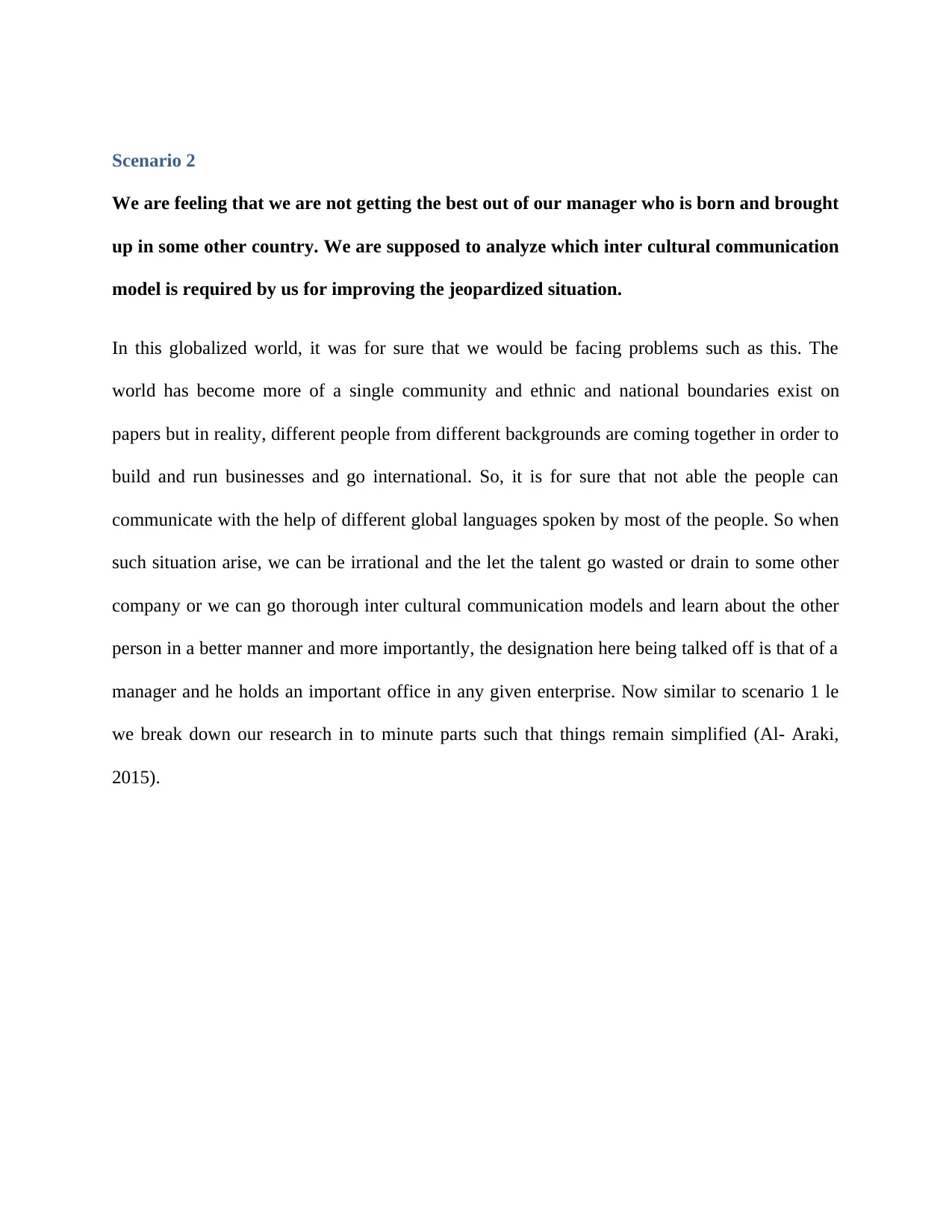
Scenario 2
We are feeling that we are not getting the best out of our manager who is born and brought
up in some other country. We are supposed to analyze which inter cultural communication
model is required by us for improving the jeopardized situation.
In this globalized world, it was for sure that we would be facing problems such as this. The
world has become more of a single community and ethnic and national boundaries exist on
papers but in reality, different people from different backgrounds are coming together in order to
build and run businesses and go international. So, it is for sure that not able the people can
communicate with the help of different global languages spoken by most of the people. So when
such situation arise, we can be irrational and the let the talent go wasted or drain to some other
company or we can go thorough inter cultural communication models and learn about the other
person in a better manner and more importantly, the designation here being talked off is that of a
manager and he holds an important office in any given enterprise. Now similar to scenario 1 le
we break down our research in to minute parts such that things remain simplified (Al- Araki,
2015).
We are feeling that we are not getting the best out of our manager who is born and brought
up in some other country. We are supposed to analyze which inter cultural communication
model is required by us for improving the jeopardized situation.
In this globalized world, it was for sure that we would be facing problems such as this. The
world has become more of a single community and ethnic and national boundaries exist on
papers but in reality, different people from different backgrounds are coming together in order to
build and run businesses and go international. So, it is for sure that not able the people can
communicate with the help of different global languages spoken by most of the people. So when
such situation arise, we can be irrational and the let the talent go wasted or drain to some other
company or we can go thorough inter cultural communication models and learn about the other
person in a better manner and more importantly, the designation here being talked off is that of a
manager and he holds an important office in any given enterprise. Now similar to scenario 1 le
we break down our research in to minute parts such that things remain simplified (Al- Araki,
2015).
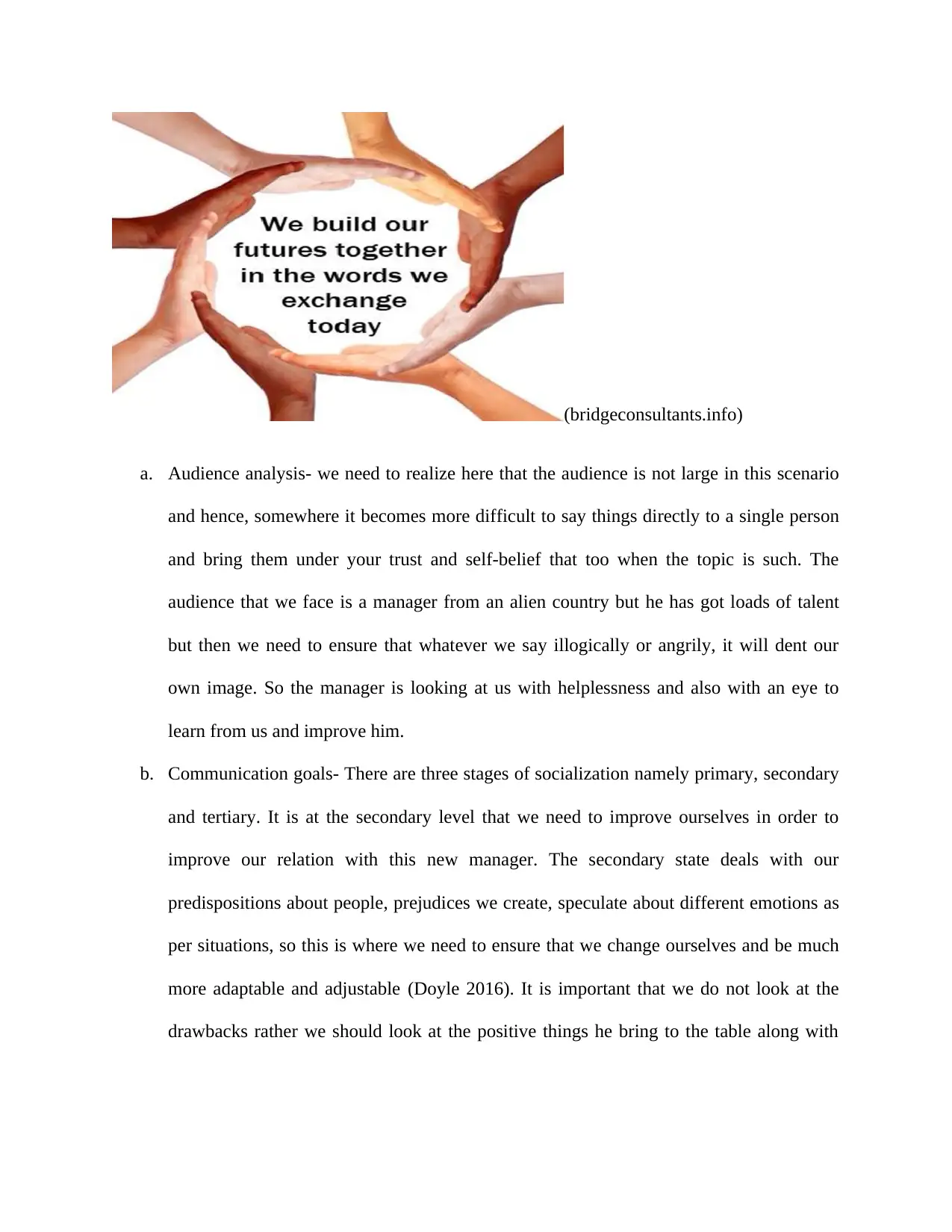
(bridgeconsultants.info)
a. Audience analysis- we need to realize here that the audience is not large in this scenario
and hence, somewhere it becomes more difficult to say things directly to a single person
and bring them under your trust and self-belief that too when the topic is such. The
audience that we face is a manager from an alien country but he has got loads of talent
but then we need to ensure that whatever we say illogically or angrily, it will dent our
own image. So the manager is looking at us with helplessness and also with an eye to
learn from us and improve him.
b. Communication goals- There are three stages of socialization namely primary, secondary
and tertiary. It is at the secondary level that we need to improve ourselves in order to
improve our relation with this new manager. The secondary state deals with our
predispositions about people, prejudices we create, speculate about different emotions as
per situations, so this is where we need to ensure that we change ourselves and be much
more adaptable and adjustable (Doyle 2016). It is important that we do not look at the
drawbacks rather we should look at the positive things he bring to the table along with
a. Audience analysis- we need to realize here that the audience is not large in this scenario
and hence, somewhere it becomes more difficult to say things directly to a single person
and bring them under your trust and self-belief that too when the topic is such. The
audience that we face is a manager from an alien country but he has got loads of talent
but then we need to ensure that whatever we say illogically or angrily, it will dent our
own image. So the manager is looking at us with helplessness and also with an eye to
learn from us and improve him.
b. Communication goals- There are three stages of socialization namely primary, secondary
and tertiary. It is at the secondary level that we need to improve ourselves in order to
improve our relation with this new manager. The secondary state deals with our
predispositions about people, prejudices we create, speculate about different emotions as
per situations, so this is where we need to ensure that we change ourselves and be much
more adaptable and adjustable (Doyle 2016). It is important that we do not look at the
drawbacks rather we should look at the positive things he bring to the table along with
⊘ This is a preview!⊘
Do you want full access?
Subscribe today to unlock all pages.

Trusted by 1+ million students worldwide

him from his experience from his own country. Some of the salient goals for us should be
(Heathfield, 2017):-
a. Be cooperative and listen to their thoughts and if that is not possible we need to
ensure that we are sharing a lot of power points and brainstorming such that we
soon align with each other thought process
b. We should hang out with our manager for informal meets as that will keep the
tension and formality bar below par and two people would actually be able to talk
and discuss without any hindrance.
c. We need to ensure that we show him work of previous managers and how they
have helped us throughout; this will give him jist about the track which he is
supposed to follow. Once, the secondary stage of socialization is over we will
more to the tertiary stage.
d. In the third and last stage of socializing, we compare ourselves with others and
see where we stand in front of them. Different sounds, movements, attitude and
nature make us curious to look into our culture and also force us to be curious
enough to look in to other cultures.
e. We are supposed to follow the six step ladder model that tells us about
communication skills. There also we see that it is all about not disrespecting the
self-esteem of other person, being attentive to what they say, understanding them
and ensuring each other’s comfort zone.
f. We need to let people from their culture in the company to interact with him and
ensure that we give crucial inputs to the third person before he interacts with our
manager. This will make him more comfortable and trust the organization.
(Heathfield, 2017):-
a. Be cooperative and listen to their thoughts and if that is not possible we need to
ensure that we are sharing a lot of power points and brainstorming such that we
soon align with each other thought process
b. We should hang out with our manager for informal meets as that will keep the
tension and formality bar below par and two people would actually be able to talk
and discuss without any hindrance.
c. We need to ensure that we show him work of previous managers and how they
have helped us throughout; this will give him jist about the track which he is
supposed to follow. Once, the secondary stage of socialization is over we will
more to the tertiary stage.
d. In the third and last stage of socializing, we compare ourselves with others and
see where we stand in front of them. Different sounds, movements, attitude and
nature make us curious to look into our culture and also force us to be curious
enough to look in to other cultures.
e. We are supposed to follow the six step ladder model that tells us about
communication skills. There also we see that it is all about not disrespecting the
self-esteem of other person, being attentive to what they say, understanding them
and ensuring each other’s comfort zone.
f. We need to let people from their culture in the company to interact with him and
ensure that we give crucial inputs to the third person before he interacts with our
manager. This will make him more comfortable and trust the organization.
Paraphrase This Document
Need a fresh take? Get an instant paraphrase of this document with our AI Paraphraser
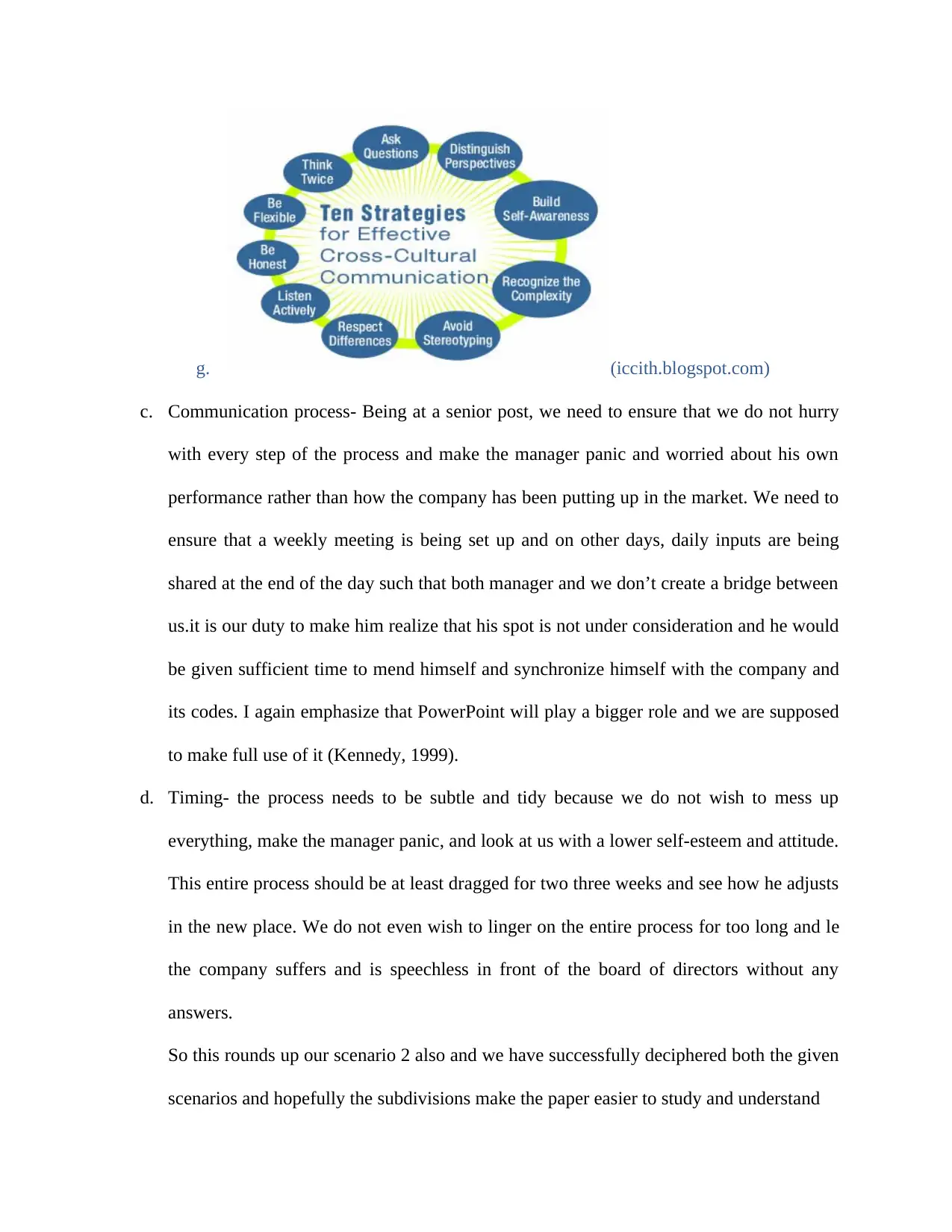
g. (iccith.blogspot.com)
c. Communication process- Being at a senior post, we need to ensure that we do not hurry
with every step of the process and make the manager panic and worried about his own
performance rather than how the company has been putting up in the market. We need to
ensure that a weekly meeting is being set up and on other days, daily inputs are being
shared at the end of the day such that both manager and we don’t create a bridge between
us.it is our duty to make him realize that his spot is not under consideration and he would
be given sufficient time to mend himself and synchronize himself with the company and
its codes. I again emphasize that PowerPoint will play a bigger role and we are supposed
to make full use of it (Kennedy, 1999).
d. Timing- the process needs to be subtle and tidy because we do not wish to mess up
everything, make the manager panic, and look at us with a lower self-esteem and attitude.
This entire process should be at least dragged for two three weeks and see how he adjusts
in the new place. We do not even wish to linger on the entire process for too long and le
the company suffers and is speechless in front of the board of directors without any
answers.
So this rounds up our scenario 2 also and we have successfully deciphered both the given
scenarios and hopefully the subdivisions make the paper easier to study and understand
c. Communication process- Being at a senior post, we need to ensure that we do not hurry
with every step of the process and make the manager panic and worried about his own
performance rather than how the company has been putting up in the market. We need to
ensure that a weekly meeting is being set up and on other days, daily inputs are being
shared at the end of the day such that both manager and we don’t create a bridge between
us.it is our duty to make him realize that his spot is not under consideration and he would
be given sufficient time to mend himself and synchronize himself with the company and
its codes. I again emphasize that PowerPoint will play a bigger role and we are supposed
to make full use of it (Kennedy, 1999).
d. Timing- the process needs to be subtle and tidy because we do not wish to mess up
everything, make the manager panic, and look at us with a lower self-esteem and attitude.
This entire process should be at least dragged for two three weeks and see how he adjusts
in the new place. We do not even wish to linger on the entire process for too long and le
the company suffers and is speechless in front of the board of directors without any
answers.
So this rounds up our scenario 2 also and we have successfully deciphered both the given
scenarios and hopefully the subdivisions make the paper easier to study and understand

⊘ This is a preview!⊘
Do you want full access?
Subscribe today to unlock all pages.

Trusted by 1+ million students worldwide
1 out of 13
Related Documents
Your All-in-One AI-Powered Toolkit for Academic Success.
+13062052269
info@desklib.com
Available 24*7 on WhatsApp / Email
![[object Object]](/_next/static/media/star-bottom.7253800d.svg)
Unlock your academic potential
Copyright © 2020–2025 A2Z Services. All Rights Reserved. Developed and managed by ZUCOL.





